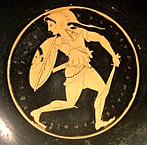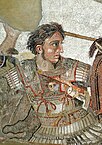Gorgons
This article needs additional citations for verification. (January 2022) |

| Part of a series on |
| Greek mythology |
|---|
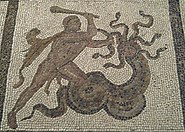 |
| Deities |
| Heroes and heroism |
| Related |
|
|
The Gorgons (/ˈɡɔːrɡənz/ GOR-gənz; Ancient Greek: Γοργώνες), in Greek mythology, are three female monsters, Stheno, Euryale, and Medusa, sisters who were able to turn anyone who looked at them to stone. Euryale and Stheno were immortal, but Medusa was not and was slain by the hero Perseus.[1]
Family[edit]
According to Hesiod and Apollodorus, the Gorgons were daughters of the primordial sea-god Phorcys and the sea-monster Ceto, and the sisters of three other daughters of Phorcys and Ceto, the Graeae.[2] However according to Hyginus, they were daughters of "the Gorgon", an offspring of Typhon and Echidna, and Ceto,[3] while Euripides, in his tragedy Ion, has "the Gorgon" being the offspring of Gaia, spawned by Gaia to be an ally for her children the Giants in their war against the Olympian gods.[4]
Mythology[edit]
Dwelling place[edit]
Where the Gorgons were supposed to live varies in the ancient sources.[5] According to Hesiod, the Gorgons lived far to the west beyond Oceanus (the Titan, and world-circling river) near its springs, at the edge of night where the Hesperides (and the Graeae?) live.[6] The Cypria apparently had the Gorgons living in Oceanus on a rocky island named Sarpedon.[7] Aeschylus's Prometheus Bound places them in the far east "across the surging sea" on the "Gorgonean plains of Cisthene", where the Graeae live, while his lost play Phorkides (another name for the Graeae) apparently placed them at "Lake Tritonis", a mythological lake set somewhere in westernmost North Africa.[8] And the poet Pindar has Perseus, apparently on his quest for the Gorgon head, visit the Hyperboreans (usually considered to dwell in the far north). However, whether Pindar means to imply that the Gorgons lived near the Hyperboreans is unclear.[9]
Petrification[edit]
Pherecydes tells us that Medusa's face turned men to stone, and Pindar describes Medusa's severed head as "stony death".[10] In the Prometheus Bound, it says that no mortal can look at them and live.[11] According to Apollodorus, all three of the Gorgons could turn to stone anyone who saw them.[12]
Perseus and Medusa[edit]
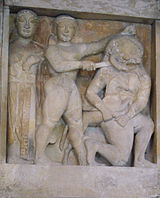
Stheno and Euryale were immortal, whereas Medusa was mortal.[13] According to Apollodorus' version of their story, Perseus was ordered by Polydectes (his enemy) to bring back the head of Medusa. So guided by Hermes and Athena, he sought out the sisters of the Gorgons, the Graeae who had only one eye and one tooth which they shared. Perseus managed to steal their eye and tooth, and refused to return them, unless they would show him the way to the nymphs, which they did. Perseus got from the nymphs, winged sandals, which allowed him to fly, and the cap of Hades, with made him invisible. He also received an adamantine sickle (harpē) from Hermes. Perseus then flew to Oceanus, found the Gorgons asleep. And when Perseus managed to behead Medusa by looking at her reflection in his bronze shield, Stheno and Euryale chased after him, but were unable to see him because he was wearing Hades' cap of invisiblity. When Perseus brought back the Gorgon head, as ordered, with averted eyes he showed the head to Polydectes who was turned to stone. Perseus returned the things he had acquired from the nymphs and Hermes, but gave the Gorgon head to Athena.[14]
Athena's Gorgon aegis[edit]

According to Apollodorus, after Peseus gave the Gorgon head to Athena, she "inserted the Gorgon's head in the middle of her shield",[16] apparently a reference to Athena's aegis. In the Iliad, the aegis is a device, usually associated with Athena, which was decorated with a Gorgon head.[17] Athena wore it in battle as a shield which neither Apollo's spear, or even Zeus' thunderbolt could pierce.[18] According to the Iliad, Hephaestus made the aegis for Zeus, while according to a Hesiod fragment, Metis made it for Athena, before Athena was born. However, Euripides, in his tragedy Ion, has a character say that Athena's aegis was made from the skin of the Gorgon, the offspring of Gaia, who Gaia had brought forth as an ally for her children the Giants and who Athena had killed during the Gigantomachy.[19] In vase-painting, Athena is often shown wearing her aegis, fringed with snake-heads.[20]
Etymology[edit]
The name derives from the Ancient Greek word gorgós (γοργός), which means 'grim or dreadful', and appears to come from the same root as the Sanskrit word garjana (गर्जन), which means a guttural sound, similar to the growling of a beast,[21] thus, possibly originating as an onomatopoeia.
Literary descriptions[edit]
Hesiod provides no physical description of the Gorgons, other than to say that the two Gorgons, Sthenno, and Euryale did not grow old.[22] Homer mentions only "the Gorgon" giving brief descriptions of her, and her head. In the Iliad she is called a "dread monster" and the image of her head, which appears—along with several other terrifying images—on Athena's aegis, and Agamemnon's shield, is described as "dread and awful", and "grim of aspect, glaring terribly".[23] Already in the Iliad, the Gorgon's "glaring" eyes were a notably fearsome feature. As Hector pursues the fleeing Achaeans, "exulting in his might" ... ever slaying the hindmost", Homer describes the Trojan hero as having eyes like "the eyes of the Gorgon".[24] And in the Odyssey, Odysseus, although determined "steadfastly" to stay in the underworld, so as to meet other great men among the dead, is seized by such fear at the mere thought that he might encounter there the "head of the Gorgon, that awful monster", leaves "straightway".[25]
The Hesiodic Shield of Heracles describes the Gorgons chasing Perseus as being "dreadful and unspeakable" with two snakes wrapped around their waists, and that "upon the terrible heads of the Gorgons rioted great Fear", perhaps a reference to snakes writhing about their heads.[26] Pindar makes snakes for hair explicit, saying that Perseus' Gorgon head "shimmered with hair made of serpents", and that the Gorgons chasing Perseus also had "horrible snaky hair", so too in Prometheus Bound where all three Gorgons are described as "winged" as well as "snake-haired".[27] The mythographer Apollodorus gives the most detailed description:
... the Gorgons had heads twined about with the scales of dragons, and great tusks like swine's, and brazen hands, and golden wings, by which they flew".[28]
While such descriptions emphasize the hideous physical features of the Gorgon, by the fifth century BC, Pindar can also describe his snake-haired Medusa as "beautiful".[29] And the Roman poet Ovid tells us that Medusa was originally a beautiful maiden, but because of a sexual encounter with Neptune (the Roman equivalent of the Greek Poseidon) in Minerva's temple (Minerva being the Roman equivalent of the Greek Athena), Minerva punished Medusa by transforming her beautiful hair into horrible snakes.[30]
Iconography[edit]
Gorgons were a popular subject in ancient Greek, Etruscan and Roman art, with over six hundred representations cataloged in the Lexicon Iconographicum Mythologiae Classicae (LIMC).[31] Some representations show full-bodied Gorgons, while others, called gorgoneia, show only the disembodied full-frontal face of a Gorgon, such as those described in the Iliad as appearing on Athena's aegis, and Agamemnon's shield.[32] The earliest representations of both types are found from roughly the same time period, the mid seventh century BC.[33] Full-bodied Gorgons are usually shown in connection with the Perseus-Medusa story, while the disembodied gorgoneia, thought to have had an apotropaic (protective) function, are often found on architectural elements such as temple pediments, and ornamental antefixes and acroteria, or decorating various round objects, such as shields, coins, and the bottoms of bowls and cups.[34]
Archaic Gorgon faces, weather on Gorgons or gorgoneia, are particularly distinctive, with large menacing eyes, wide mouths with rictus-like grins, lolling tongues, and fangs and tusks protruding both up and down, a tripartite nose, and serpentine-curling hair, often with actual snakes.[35]
The earliest representations of full-bodied Gorgons are a Boeotian relief pithos (Louvre CA 795), which depicts Perseus, with head turned away, decapitating a Gorgon, and the Eleusis Amphora, which shows two Gorgons chasing Perseus fleeing with a severed Gorgon head.[36] That the Perseus, on the pithos, averts his gaze shows that already in these earliest images it was understood that looking directly at the Gorgon's face was deadly.[37]
Although the Gorgon being beheaded on the Boeotian pithos is depicted as a female Centaur, with neither wings nor snakes present, and the Gorgons on the Eleusis Amphora, have wingless, wasp-shaped bodies with cauldron-like heads, by the end of the seventh century BC, humanoid bodies, with wings, and snakes around their head, necks, or waist, become typical.[38] Unlike the depictions of gods and heroes, which are usually shown in profile, Archaic Gorgons, even when their bodies are presented profile (usually running), their heads are turned to display their full face, with their large bulging eyes glaring directly at the viewer.[39]
Consistent with the change in literary descriptions seen in the works of Pindar and Ovid mentioned above, beginning in the fifth century BC, images of Gorgons and gorgoneia transition from hideous monsters to beautiful young women, with such representations becoming typical in the fourth century BC.[40] One of the earliest such "beautiful" Gorgons (mid fifth century BC) is a red-figure Pelike (Metropolitan Museum of Art 45.11.1), which shows Perseus, with head turned away, about to behead a sleeping Medusa.[41] While gorgoneia continue to be ubiquitous through the end of antiquity, after the fourth century BC full-bodied Gorgons ceased to be represented.[42]
-
Two Gorgons chase Perseus (on the body of the vase below the neck); Eleusis Amphora (mid seventh century BC)[44]
-
Winged Gorgon, large-eyed, lolling tongue, running right with head turned facing out; name vase of the Nessos Painter, Athens, National Archaeological Museum 1002 (late seventh–early sixth century BC)[45]
-
Two Gorgons (center and right) chase Perseus, with a headless Gorgon (left); Dinos of the Gorgon Painter, Lourve E874 (early sixth century BC)[46]
-
Gorgon with snakey hair, and belt of snakes; pediment from the temple of Artemis in Corfu, on display at the Archaeological Museum of Corfu (early sixth century BC)
-
Perseus decaptitating the Gorgon; fragment of ivory relief plaque from the Heraion of Samos Archaeological Museum of Samos E 1 (sixth century BC)
-
Disk-fibula with a gorgoneion, bronze with repoussé decoration, second half of the 6th century BC (Louvre)
-
Perseus about to behead a "beautiful" sleeping Medusa; Pelike, attributed to Polygnotos, Metropolitan Museum of Art 45.11.1 (mid fourth century BC)[48]
-
"Beautiful" gorgoneia, with small head wings and two snakes twined under her chin; the Medusa Rondanini, Munich, Glyptothek 252 (first-second century AD, Roman copy of a 5th-century B.C. Greek original?)[49]
Origins[edit]

A number of early classics scholars interpreted the myth of the Medusa as a quasi-historical, or "sublimated", memory of an actual invasion.[50][a]
The legend of Perseus beheading Medusa means, specifically, that "the Hellenes overran the goddess's chief shrines" and "stripped her priestesses of their Gorgon masks", the latter being apotropaic faces worn to frighten away the profane.
That is to say, there occurred in the early thirteenth century B.C. an actual historic rupture, a sort of sociological trauma, which has been registered in this myth, much as what Freud terms the latent content of a neurosis is registered in the manifest content of a dream: Registered yet hidden, registered in the unconscious yet unknown or misconstrued by the conscious mind.
— J. Campbell (1968)[52][b]
While seeking origins others have suggested examination of some similarities to the Babylonian creature, Humbaba, in the Gilgamesh epic.[53]
Classical tradition[edit]
Transitions in religious traditions over such long periods of time may make some strange turns. Gorgons are often depicted as having wings, brazen claws, the tusks of boars, and scaly skin. The oldest oracles were said to be protected by serpents and a Gorgon image was often associated with those temples. Lionesses or sphinxes are frequently associated with the Gorgon as well. The powerful image of the Gorgon was adopted for the classical images and myths of Athena and Zeus, perhaps being worn in continuation of a more ancient religious imagery. In late myths, the Gorgons were said to be the daughters of two sea deities: Keto, the sea monster, and Phorcys, her brother-husband.
The Bibliotheca provides a good summary of the Gorgon myth. Much later stories claim that each of three Gorgon sisters, Stheno, Euryale, and Medusa, had snakes for hair, and that they had the power to turn anyone who looked at them to stone. According to Ovid, a Roman poet writing in 8 AD, whose most famous work was heavily involved in the depiction of Greek myths, Medusa alone had serpents in her hair, and he explained that this was due to Athena (Roman Minerva) cursing her. Medusa had copulated with Poseidon (Roman Neptune) in a temple of Athena after he was aroused by the golden color of Medusa's hair. Athena therefore changed the enticing golden locks into serpents.
Virgil mentions that the Gorgons lived in the entrance of the Underworld. Diodorus and Palaephatus mention that the Gorgons lived in the Gorgades, islands in the Aethiopian Sea. The main island was called Cerna. Henry T. Riley suggests these islands may correspond to Cape Verde.
-
An Amazon with her shield bearing the Gorgon head image. Tondo of an Attic red-figure kylix, 510–500 BC
-
First century BC mosaic of Alexander the Great bearing on his armor an image of the Gorgon as an aegis (Naples National Archaeological Museum)
-
Gorgon in medaillon. Roman fresco from the House of the Vettii (VI 15,1) in Pompeii
Protective and healing powers[edit]

In Ancient Greece a Gorgoneion (a stone head, engraving, or drawing of a Gorgon face, often with snakes protruding wildly and the tongue sticking out between her fangs) frequently was used as an apotropaic symbol and placed on doors, walls, floors, coins, shields, breastplates, and tombstones in the hopes of warding off evil. In this regard, Gorgoneia are similar to the sometimes grotesque faces on Chinese soldiers’ shields, also used generally as an amulet, a protection against the evil eye. Likewise, in Hindu mythology, Kali is often shown with a protruding tongue and snakes around her head.
The Ancient Silver Gorgon Coin is a hemidrachm that was struck in the Greek city of Parium in the 5th century B.C. Parium was a major coastal cite in the Mysia region on the Hellespont, the peninsula now known as the Dardanelles in western Turkey. The city was close to the Greek region of Lydia, which produced the first coins in about 650 B.C. The Gorgon coin from Parium was issued only a few generations later, making it one of the world's earliest coins. Ancient Greek coins usually feature images of specific Gods or symbols that represented the issuing city or state, and it is likely that the Parium had a connection to the legends of the Gorgons. The ancient Greeks believed that the Gorgons lived in the west, near the setting sun, and since Parium was near the western limits if the known Greek world, it was an appropriate place for the Gorgon Coin to be issued.[54]
In some Greek myths, blood taken from the right side of a Gorgon could bring the dead back to life, yet blood taken from the left side was an instantly fatal poison.[55] Athena gave a vial of healing blood to Asclepius, which ultimately brought about his demise.
Heracles is said to have obtained a lock of Medusa's hair (which possessed the same powers as the head) from Athena and to have given it to Sterope,[56] the daughter of Cepheus, as a protection for the town of Tegea against attack. According to the later idea of Medusa as a beautiful maiden, whose hair had been changed into snakes by Athena, the head was represented in works of art with a wonderfully handsome face, wrapped in the calm repose of death.[57]
Cultural depictions[edit]
Gorgons, especially Medusa, have become a common image and symbol in Western culture since their origins in Greek mythology, appearing in art, literature, and elsewhere throughout history. In A Tale of Two Cities, for example, Charles Dickens compares the exploitative French aristocracy to "the Gorgon" — even devoting an entire chapter to this extended metaphor.
One of the more recent and famous uses of Gorgons comes from the book series Percy Jackson and the Olympians, in which we see Medusa in the first book. Her sisters, Stheno and Euryale, are seen later in the series.
Another modern depiction of Gorgons is seen in the movie Clash of the Titans, a movie loosely based on the tale of Perseus.
In the Fate/stay night visual novel, Medusa appears as the Rider-class servant in her pre-transformation human form. Later installments of the franchise expand on her and introduce her sisters. In the Fate franchise's fictional universe, the three sisters were originally worshipped as chthonic deities before being exiled to their island by rival cults. Rumors of her monstrous nature eventually transformed Medusa against her will into the Gorgon, who then devoured Stheno and Euryale.
The 2023 book Medusa’s Sisters tells the story of the Gorgons from their perspective.
Notes[edit]
- ^ A large part of Greek myth is politico-religious history. Bellerophon masters winged Pegasus and kills the Chimaera. Perseus, in a variant of the same legend, flies through the air and beheads Pegasus’s mother, the Gorgon Medusa; much as Marduk, a Babylonian hero, kills the she-monster Tiamat, Goddess of the Seal. Perseus’s name should properly be spelled Perseus, ‘the destroyer’; and he was not, as Professor Kerenyi has suggested, an archetypal Death-figure but, probably, represented the patriarchal Hellenes who invaded Greece and Asia Minor early in the second millennium BC, and challenged the power of the Triple-goddess. Pegasus had been sacred to her because the horse with its moon-shaped hooves figured in the rain-making ceremonies and the installment of sacred kings; his wings were symbolical of a celestial nature, rather than speed. Jane Harrison has pointed out[50] that Medusa was once the goddess herself, hiding behind a prophylactic Gorgon mask: A hideous face intended to warn the profane against trespassing on her Mysteries. Perseus beheads Medusa: that is, the Hellenes overran the goddess’s chief shrines, stripped her priestesses of their Gorgon masks, and took possession of the sacred horses – an early representation of the goddess with a Gorgon’s head and a mare’s body has been found in Boeotia. Bellerophon, Perseus’s double, kills the Lycian Chimaera, that is: The Hellenes annulled the ancient Medusan calendar, and replaced it with another.
— R. Graves (1955)[51] - ^ We have already spoken of Medusa and of the powers of her blood to render both life and death. We may now think of the legend of her slayer, Perseus, by whom her head was removed and presented to Athene. Professor Hainmond assigns the historical King Perseus of Mycenae to a date c. 1290 B.C., as the founder of a dynasty; and Robert Graves – whose two volumes on The Greek Myths are particularly noteworthy for their suggestive historical applications – proposes that the legend of Perseus beheading Medusa means, specifically, that "the Hellenes overran the goddess's chief shrines" and "stripped her priestesses of their Gorgon masks", the latter being apotropaic faces worn to frighten away the profane. That is to say, there occurred in the early thirteenth century B.C. an actual historic rupture, a sort of sociological trauma, which has been registered in this myth, much as what Freud terms the latent content of a neurosis is registered in the manifest content of a dream: Registered yet hidden, registered in the unconscious yet unknown or misconstrued by the conscious mind. And in every such screening myth – in every such mythology (that of the Bible being, as we have just seen, another of the kind) – there enters in an essential duplicity, the consequences of which cannot be disregarded or suppressed.
— J. Campbell (1968)[52]
References[edit]
- ^ Bremmer 2006, s.v. Gorgo 1; Bremmer 2015, s.v. Gorgo/Medusa; Gantz, p. 20; Grimal, s.v. Gorgons; Tripp, s.v. Gorgons.
- ^ Gantz, p. 19; Hesiod, Theogony 270–277; Apollodorus, 1.2.6, 2.4.2 (calling the Graeae the "Phorcides").
- ^ Tripp, s.v. Gorgons; Hyginus, Fabulae Preface 9, 35.
- ^ Euripides, Ion 986–991.
- ^ Fowler 2013, p. 252; Hard 2004, pp. 59–60; Gantz, p. 20.
- ^ Fowler 2013, p. 254; Gantz, p. 20; Hesiod, Theogony 274–282. As to whether Hesiod means to include the Graeae as also living there, Fowler reads Hesiod as including the Graeae, while Gantz does not. Compare with Apollodorus, 2.4.2, which has Perseus fly to "the ocean" [i.e Oceanus] to find the Gorgons.
- ^ Bremmer 2006, s.v. Gorgo 1; Hard 2004, p. 60; Ganz, p. 20; West 2006, p. 246 line 274 πέρην κλυτοῦ Ὠκεανοῖο; West 2003, Cypria fr. 30 West [= fr. 24 Allen = fr. 32 Bernabé]. Pherecydes also has the Gorgons living somewhere in Oceanus, see Gantz, p. 20; Pherecydes fr. 11 Fowler (Fowler 2000, pp. 280–281) [= Scolia on Apollonius of Rhodes 4.1515a].
- ^ Fowler 2013, p. 254; Hard 2015, p. 176 16 Tritonis; Sommerstein, pp. 260–261; Aeschylus (?), Prometheus Bound 790–800; Aeschylus fr. 262 [= Eratosthenes, Catasterismi 22 (Hard 2015, p. 16)]. For lake Tritonis, and the Gorgons being located in North Africa, see also: Herodotus, 2.91.6, 4.178, 4.186.1; Pausanias, 3.17.3.
- ^ Fowler 2013, p. 254; Bremmer (2006), s.v. Gorgo 1; Gantz, p. 20 ; Pindar, Phythian 10.30–48. Although Bremmer reads Pindar as having located the Gorgons "among the Hyperboreans", Fowler does not conclude that Pindar did this, while Gantz says that Pindar "may or may not" have done so.
- ^ Gantz, p. 20; Pherecydes fr. 11 Fowler (Fowler 2000, pp. 280–281) [= Scolia on Apollonius of Rhodes 4.1515a]; Pindar, Phythian 10.46–48.
- ^ Gantz, p. 20; Aeschylus (?), Prometheus Bound 800.
- ^ Apollodorus, 2.4.2.
- ^ Hesiod, Theogony 270–277; Apollodorus, 2.4.2.
- ^ Bremmer, s.v. Gorgo/Medusa (which calls Apollodorus' version "canonical"); Apollodorus, 2.4.2–3. See also Aeschylus (?), Prometheus Bound 798–800.
- ^ Beazley Archive 203217; LIMC 46725; Perseus Digital Library, Louvre G 104 (Vase).
- ^ Apollodorus, 2.4.2–3.
- ^ Gantz, pp. 84–85; Homer, Iliad 5.738–742. For a detailed discussion of Athena's Gorgon aegis see Cook, pp. 837–867.
- ^ Gantz, p. 84; Iliad 5.738–742, 21.400–402.
- ^ Gantz, p. 84; Homer, Iliad 15.309–310; Hesiod fr. 294 Most [= 343 MW]; Euripides, Ion 987–997. Other accounts name other opponents whom Athena was supposed to have killed and flayed for her aegis, including the Giant Pallas (Apollodorus, 1.6.2), an invulnerable Koan warrior Asterius, and others, see Robertson, p. 42.
- ^ Hard 2004, p. 74.
- ^ Feldman, Thalia (1965). "Gorgo and the origins of fear". Arion. 4 (3): 484–94. JSTOR 20162978.
- ^ Gantz, p. 20; Hesiod, Theogony 276–277.
- ^ Gantz, p. 85; Homer, Iliad 5.738–742 (Athena's aegis), 11.32–37 (Agamemnon's shield).
- ^ Ogden 2006, p. 34; Homer, Iliad 8.337–349.
- ^ Homer, Odyssey 11.630–37.
- ^ Gantz, p. 20; Shield of Heracles 229–237 (Most, pp. 18–21).
- ^ Gantz, p. 20; Pindar, Phythian 10.46–48, 12.10–14; Aeschylus (?), Prometheus Bound 799.
- ^ Apollodorus, 2.4.2.
- ^ Pindar, Pythian 12.16.
- ^ Ovid, Metamorphoses 4.794–803.
- ^ Bremmer 2015, s.v. Gorgo/Medusa; Ogden 2013, p. 93; Krauskopf and Dahlinger, pp. 285–330 (images: LIMC IV-2, pp. 163–188); Krauskopf, pp. 330–345 (images: LIMC IV-2, pp. 188–195); Paoletti, pp. 345–362 (images: LIMC IV-2, pp. 195–207.
- ^ Homer, Iliad 5.738–742 (Athena's aegis), 11.32–37 (Agamemnon's shield).
- ^ Ogden 2013, p. 93.
- ^ Ogden 2013, p. 93; Wilk, p. 33. For a discussion of the apotropaic function of gorgoneia, see Ogden 2006, p. 37.
- ^ Ogden 2013, p. 93; Wilk, pp. 32–33; Gantz, p. 21.
- ^ Ogden 2013, p. 93; Ogden 2008, pp. 35–34; Gantz, pp. 21, 304; Perseus Medusa Louvre CA795; Near, p. 106 (Eleusis Amphora).
- ^ Ogden 2008, p. 36.
- ^ Ogden 2013, p. 93; Ogden 2008, pp. 35–36; Gantz, p. 21.
- ^ Wilk, pp. 32–33. Ogden 2008, p. 35, describes this "direct frontal stare, seemingly looking out from its own iconographical context and directly challenging the viewer" as "a shocking and highly exceptional thing in the context of Greek two-dimensional imagery."
- ^ Ogden 2013, p. 96; Karoglou, p. 9.
- ^ Karoglou, pp. 9–10.
- ^ Karoglou, pp.11–12.
- ^ Gantz, p. 21; Perseus Medusa Louvre CA795; LIMC 9731 (Gorgo, Gorgones 290).
- ^ Gantz, p. 21; Near, p. 106; LIMC 9830 (Gorgo, Gorgones 312).
- ^ Gantz, p. 21; Beazley Archive 300025; LIMC 13680 (Gorgo, Gorgones 313).
- ^ Gantz, p. 21; Perseus Louvre E 874 (Vase); Beazley Archive 300055; LIMC 4022 (Gorgo, Gorgones 314).
- ^ Beazley Archive 302907; LIMC 35646
- ^ Karoglou, pp. 9–10; Beazley Archive 213438; Metropolitan Museum of Art 45.11.1.
- ^ Karoglou, pp. 14, 16; Ogden 2013, p. 96.
- ^ a b Harrison, Jane Ellen (5 June 1991) [1908]. Prolegomena to the Study of Greek Religion. Princeton, New Jersey: Princeton University Press. pp. 187–188. ISBN 978-0691015149.
- ^ Graves, Robert (1955). The Greek Myths. Penguin Books. pp. 17, 244. ISBN 978-0241952740.
- ^ a b Campbell, Joseph (1968). Occidental Mythology. The Masks of God. Vol. 3. Penguin Books. pp. 152–153. ISBN 978-0140194418.
- ^ Hopkins, Clark (1934). Assyrian Elements in the Perseus-Gorgon Story. American Journal of Archaeology. Vol. 38. Archaeological Institute of America. pp. 341–358. doi:10.2307/498901. JSTOR 498901. S2CID 191408685.
- ^ Steven Bonacorsi, President of the International standard for Lean Six Sigma (ISLSS) and Owner of the NGC Gorgon Coin Certified by NGC https://www.ngccoin.com/certlookup/5873659-131/NGCAncients/, and Purchased by PCS https://www.pcscoins.com/home
- ^ "Euripides, Ion, line 998". www.perseus.tufts.edu. Retrieved 2023-04-26.
- ^ "Apollodorus, Library, book 2, chapter 7". www.perseus.tufts.edu. Retrieved 2023-04-26.
- ^ Chisholm 1911.
Sources[edit]
- Aeschylus, Fragments, edited and translated by Alan H. Sommerstein, Loeb Classical Library No. 505, Cambridge, Massachusetts, Harvard University Press, 2009. ISBN 978-0-674-99629-8. Online version at Harvard University Press.
- Aeschylus (?), Prometheus Bound in Aeschylus, with an English translation by Herbert Weir Smyth, Ph. D. in two volumes. Vol 2. Cambridge, Massachusetts, Harvard University Press. 1926. Online version at the Perseus Digital Library.
- Apollodorus, Apollodorus, The Library, with an English Translation by Sir James George Frazer, F.B.A., F.R.S. in 2 Volumes, Cambridge, Massachusetts, Harvard University Press, London, William Heinemann Ltd. 1921. ISBN 0-674-99135-4. ISBN 9780786471119. Online version at the Perseus Digital Library.
- Bremmer, J. N. (2006), s.v. Gorgo 1, in Brill’s New Pauly, Antiquity volumes edited by: Hubert Cancik and, Helmuth Schneider, English Edition by: Christine F. Salazar, Classical Tradition volumes edited by: Manfred Landfester, English Edition by: Francis G. Gentry, published online: 2006.
- Bremmer, J. N. (2015), s.v. Gorgo/Medusa, published online 22 December 2015, in the Oxford Classical Dictionary, edited by Tim Whitmarsh, digital ed, New York, Oxford University Press. ISBN 978-0-19-938113-5.
- Cook, Arthur Bernard, Zeus: A Study in Ancient Religion, Volume III: Zeus God of the Dark Sky (Earthquakes, Clouds, Wind, Dew, Rain, Meteorites), Part I: Text and Notes, Cambridge University Press 1940. Internet Archive.
- Euripides, Ion, translated by Robert Potter in The Complete Greek Drama, edited by Whitney J. Oates and Eugene O'Neill, Jr. Volume 1. New York. Random House. 1938. Online version at the Perseus Digital Library.
- Fowler, R. L. (2000), Early Greek Mythography: Volume 1: Text and Introduction, Oxford University Press, 2000. ISBN 978-0198147404.
- Fowler, R. L. (2013), Early Greek Mythography: Volume 2: Commentary, Oxford University Press, 2013. ISBN 978-0198147411.
- Gantz, Timothy, Early Greek Myth: A Guide to Literary and Artistic Sources, Johns Hopkins University Press, 1996, Two volumes: ISBN 978-0-8018-5360-9 (Vol. 1), ISBN 978-0-8018-5362-3 (Vol. 2).
- Grimal, Pierre, The Dictionary of Classical Mythology, Wiley-Blackwell, 1996. ISBN 978-0-631-20102-1. Internet Archive.
- Hard, Robin (2004), The Routledge Handbook of Greek Mythology: Based on H.J. Rose's "Handbook of Greek Mythology", Psychology Press, 2004, ISBN 9780415186360. Google Books.
- Hard, Robin (2015), Eratosthenes and Hyginus: Constellation Myths, With Aratus's Phaenomena, Oxford University Press, 2015. ISBN 978-0-19-871698-3.
- Herodotus, Histories, A. D. Godley (translator), Cambridge, Massachusetts: Harvard University Press, 1920; ISBN 0674991338. Online version at the Perseus Digital Library.
- Hesiod, Theogony from The Homeric Hymns and Homerica with an English Translation by Hugh G. Evelyn-White, Cambridge, MA.,Harvard University Press; London, William Heinemann Ltd. 1914. Online version at the Perseus Digital Library.
- Homer, The Iliad with an English Translation by A.T. Murray, Ph.D. in two volumes. Cambridge, Massachusetts, Harvard University Press; London, William Heinemann, Ltd. 1924. Online version at the Perseus Digital Library.
- Homer, The Odyssey with an English Translation by A.T. Murray, PH.D. in two volumes. Cambridge, Massachusetts, Harvard University Press; London, William Heinemann, Ltd. 1919. Online version at the Perseus Digital Library.
- Hygynus, Fabulae from The Myths of Hyginus translated and edited by Mary Grant. University of Kansas Publications in Humanistic Studies. Online version at the Topos Text Project.
- Karoglou, Kiki, Dangerous Beauty: Medusa in Classical Art: The Metropolitan Museum of Art Bulletin, vol. 75, no. 3, Metropolitan Museum of Art, New York, 2018. ISBN 978-1-58839-642-6.
- Krauskopf, Ingrid, s.v. Gorgones (in Etrurien) in Lexicon Iconographicum Mythologiae Classicae (LIMC) IV.1. Artemis Verlag, Zürich and Munich. 1988. ISBN 3-7608-8751-1. Internet Archive.
- Krauskopf, Ingrid, Stefan-Christian Dahlinger ("literarische Quellen"), s.v. Gorgo, Gorgones in Lexicon Iconographicum Mythologiae Classicae (LIMC) IV.1. Artemis Verlag, Zürich and Munich. 1988. ISBN 3-7608-8751-1. Internet Archive.
- Most, G.W., Hesiod: The Shield, Catalogue of Women, Other Fragments, Loeb Classical Library, No. 503, Cambridge, Massachusetts, Harvard University Press, 2007, 2018. ISBN 978-0-674-99721-9. Online version at Harvard University Press.
- Neer, Richard T., Greek Art and Archaeology c.2500 – c.150 BCE, New York : Thames & Hudson, 2012. ISBN 9780500288771. Internet Archive
- Ogden, Daniel (2008), Perseus, Routledge, New York, 2008. ISBN 0-415-42725-8.
- Ogden, Daniel (2013), Drakōn: Dragon Myth and Serpent Cult in the Greek and Roman Worlds, Oxford University Press, 2013. ISBN 978-0-19-955732-5.
- Paoletti, Grazio, s.v. Gorgones Romanae, in Lexicon Iconographicum Mythologiae Classicae (LIMC) IV.1. Artemis Verlag, Zürich and Munich. 1988. ISBN 3-7608-8751-1. Internet Archive.
- Pausanias, Description of Greece with an English Translation by W.H.S. Jones, Litt.D., and H.A. Ormerod, M.A., in 4 Volumes. Cambridge, Massachusetts, Harvard University Press; London, William Heinemann Ltd. 1918. Online version at the Perseus Digital Library.
- Ovid. Metamorphoses, Volume I: Books 1–8. Translated by Frank Justus Miller. Revised by G. P. Goold. Loeb Classical Library No. 42. Cambridge, Massachusetts: Harvard University Press, 1977, first published 1916. ISBN 978-0-674-99046-3. Online version at Harvard University Press.
- Robertson, Noel, "Chapter Two: Athena as Weather-Goddess: the Aigis in Myth and Ritual" in Athena in the Classical World, edited by Susan Deacy, Alexandra Villing, Brill Academic Pub, 2001, ISBN 9789004121423.
- Sommerstein, Alan H., Aeschylus: Fragments, Edited and translated by Alan H. Sommerstein, Loeb Classical Library No. 505. Cambridge, Massachusetts, Harvard University Press, 2009. ISBN 978-0-674-99629-8. Online version at Harvard University Press.
- Tripp, Edward, Crowell's Handbook of Classical Mythology, Thomas Y. Crowell Co; First edition (June 1970). ISBN 069022608X.
- West, M. L. (1966), Hesiod: Theogony, Oxford University Press. ISBN 0-19-814169-6.
- West, M. L. (2003), Greek Epic Fragments: From the Seventh to the Fifth Centuries BC, edited and translated by Martin L. West, Loeb Classical Library No. 497, Cambridge, Massachusetts, Harvard University Press, 2003. ISBN 978-0-674-99605-2. Online version at Harvard University Press.
- Wilk, Stephen R., Medusa : Solving the Mystery of the Gorgon, Oxford University Press, New York, 2000. ISBN 0-19-512431-6. Internet Archive. Google Books.
- Zolotnikova, Olga A., "A hideous monster or a beautiful maiden? Did the Western Greeks alter the concept of Gorgon?" in Philosopher Kings and Tragic Heroes: Essays on Images and Ideas from Western Greece, Heather L. Reid and Davide Tanasi (eds.), Parnassos Press - Fonte Aretusa, May 14 2016. ISBN 978-1942495079. JSTOR j.ctvbj7gjn.23
- This article incorporates text from a publication now in the public domain: Chisholm, Hugh, ed. (1911). "Gorgon, Gorgons". Encyclopædia Britannica. Vol. 12 (11th ed.). Cambridge University Press. p. 257.
- Additional material has been added from the 1824 Lemprière's Classical Dictionary.

![Perseus, with averted gaze, decapitating Medusa (depicted here as a female centaur); Boetian relief pithos, Louvre CA 795 (mid seventh century BC)[43]](http://upload.wikimedia.org/wikipedia/commons/thumb/9/9c/Perseus_Medusa_Louvre_CA795.jpg/170px-Perseus_Medusa_Louvre_CA795.jpg)
![Two Gorgons chase Perseus (on the body of the vase below the neck); Eleusis Amphora (mid seventh century BC)[44]](http://upload.wikimedia.org/wikipedia/commons/thumb/f/ff/Funerary_proto-Attic_amphora_by_Polyphemos_painter_depicting_Odysseus_and_his_men_blinding_the_cyclops_Polyphemus_from_xxx_flickr_8706777442_b4db371a26_o.jpg/97px-Funerary_proto-Attic_amphora_by_Polyphemos_painter_depicting_Odysseus_and_his_men_blinding_the_cyclops_Polyphemus_from_xxx_flickr_8706777442_b4db371a26_o.jpg)
![Winged Gorgon, large-eyed, lolling tongue, running right with head turned facing out; name vase of the Nessos Painter, Athens, National Archaeological Museum 1002 (late seventh–early sixth century BC)[45]](http://upload.wikimedia.org/wikipedia/commons/thumb/c/c0/Nessos_Painter_-_ABV_4_1_-_Herakles_and_Nessos_-_the_three_Gorgons_-_Athens_NM_1002_-_06.jpg/170px-Nessos_Painter_-_ABV_4_1_-_Herakles_and_Nessos_-_the_three_Gorgons_-_Athens_NM_1002_-_06.jpg)
![Two Gorgons (center and right) chase Perseus, with a headless Gorgon (left); Dinos of the Gorgon Painter, Lourve E874 (early sixth century BC)[46]](http://upload.wikimedia.org/wikipedia/commons/thumb/c/cb/Dinos_du_Peintre_de_la_Gorgone_-_frag_2.jpg/170px-Dinos_du_Peintre_de_la_Gorgone_-_frag_2.jpg)

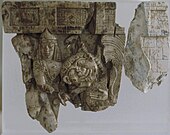

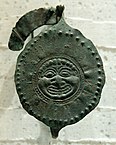

![Gorgoneion; Attic kylix cup, Paris, Cabinet des Medailles 320 (late sixth century)[47]](http://upload.wikimedia.org/wikipedia/commons/thumb/2/2c/Gorgoneion_Cdm_Paris_320.jpg/146px-Gorgoneion_Cdm_Paris_320.jpg)
![Perseus about to behead a "beautiful" sleeping Medusa; Pelike, attributed to Polygnotos, Metropolitan Museum of Art 45.11.1 (mid fourth century BC)[48]](http://upload.wikimedia.org/wikipedia/commons/thumb/9/90/Terracotta_pelike_%28jar%29_MET_DT352033.jpg/114px-Terracotta_pelike_%28jar%29_MET_DT352033.jpg)
!["Beautiful" gorgoneia, with small head wings and two snakes twined under her chin; the Medusa Rondanini, Munich, Glyptothek 252 (first-second century AD, Roman copy of a 5th-century B.C. Greek original?)[49]](http://upload.wikimedia.org/wikipedia/commons/thumb/8/8f/Rondanini_Medusa_Glyptothek_Munich_252_n1.jpg/145px-Rondanini_Medusa_Glyptothek_Munich_252_n1.jpg)
